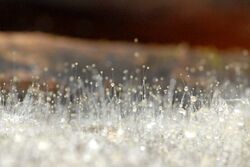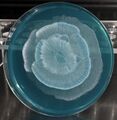Biology:Mucoromycota
| Mucoromycota | |
|---|---|

| |
| Mucor mucedo | |
| Scientific classification | |
| Domain: | Eukaryota |
| Kingdom: | Fungi |
| Subkingdom: | Mucoromyceta |
| Division: | Mucoromycota Doweld |
| Subdivision | |
Mucoromycota is a division within the kingdom fungi.[1] It includes a diverse group of various molds, including the common bread molds Mucor and Rhizopus.[2] It is a sister phylum to Dikarya.[3][4]
Informally known as zygomycetes I, Mucoromycota includes Mucoromycotina, Mortierellomycotina, and Glomeromycotina, and consists of mainly mycorrhizal fungi, root endophytes, and plant decomposers.[3] Mucoromycotina and Glomeromycotina can form mycorrhiza-like relationships with nonvascular plants.[5] Mucoromycota contain multiple mycorrhizal lineages,[6] root endophytes,[7] and decomposers of plant-based carbon sources.[8] Mucoromycotina species known as mycoparasites, or putative parasites of arthropods are like saprobes.[9] When Mucoromycota infect animals, they are seen as opportunistic pathogens.[3] Mucoromycotina are fast-growing fungi and early colonizers of carbon-rich substrates.[10] Mortierellomycotina are common soil fungi that occur as root endophytes of woody plants and are isolated as saprobes.[11] Glomeromycotina live in soil, forming a network of hyphae, but depend on organic carbon from host plants. In exchange, the arbuscular mycorrhizal fungi provide nutrients to the plant.[12]
Reproduction
Known reproduction states of Mucoromycota are zygospore production and asexual reproduction. Zygospores can have decorations on their surface and range up to several millimeters in diameter.[13] Asexual reproduction typically involves the production of sporangiospores or chlamydospores.[3] Multicellular sporcaps are present within Mucoromycotina,[14] Mortierellomycotina[15] and as aggregations of spore-producing in species of Glomeromycotina.[6] Shown in Mucorales, sexual reproduction is under the control of mating type genes, sexP and sexM, which regulate the production of pheromones required for the maturation of hyphae into gametangia.[16][13] The sexP gene is expressed during vegetative growth and matting, while the sexM gene is expressed during mating.[17] Sexual reproduction in Glomeromycotina is unknown, although its occurrence is inferred from genomic studies. However, specialized hyphae produce chlamydospore-like spores asexually; these may be borne at terminal (apical) or lateral positions on the hyphae, or intercalary (formed within the hypha, between sub-apical cells).[8] Species of Glomeromycotina produce coenocytic hyphae that can have bacterial endosymbionts.[18] Mortierellomycotina reproduce asexually by sporangia that either lack or have a reduced columella, which support the sporangium.[3] Species of Mortierellomycotina only form microscopic colonies, but some make multicellular sporocarps.[15] Mucoromycotina sexual reproduction is by prototypical zygospore formation and asexual reproduction and involves the large production of sporangia.[3]
Morphology
Mucoromycotina contain discoidal hemispherical spindle pole bodies. Although spindle pole bodies function as microtubule organizing centers, they lack remnants of the centrioles' characteristic 9+2 microtubule arrangement. Species of Mucoromycotina and Mortierellomycotina produce large-diameter, coenocytic hyphae. Glomeromycotina also form coenocytic hyphae with highly branched, narrow hyphal arbuscules in host cells. When septations occur in Mucoromycota they are formed at the base of reproductive structures.[3]
Production of lipids, polyphosphates, and carotenoids
Mucoromycota's metabolism can utilize many substrates that are from various nitrogen and phosphorus resources to produce lipids, chitin, polyphosphates, and carotenoids. They have been found to co-produce metabolites in a single fermentation process like polyphosphates and lipids.[19] The overproduction of chitin from Mucoromycota fungi can be accomplished by limiting inorganic phosphorus.[20] Mucoromycota are capable of accumulating high amounts of lipids in their cell biomass, which allows the fungi to produce polyunsaturated fatty acids and carotenoids. They have been found to induce antimicrobial activity from fungal crude total lipids.[21][22] The high production of lipids from Mucoromycota have the potential for use in biodiesel production.[23][24]
Gallery
-
Mortierella from Yosemite
-
Mucor
See also
References
- ↑ "Taxonomy browser (Mucoromycota)". https://www.ncbi.nlm.nih.gov/Taxonomy/Browser/wwwtax.cgi?mode=Info&id=1913637&lvl=3&lin=f&keep=1&srchmode=1&unlock.
- ↑ "8. Fungal sex: The Mucoromycota". The Fungal Kingdom. Wiley. 2018. pp. 177–192. ISBN 978-1-55581-958-3. https://books.google.com/books?id=VILwDwAAQBAJ&pg=PA177.
- ↑ 3.0 3.1 3.2 3.3 3.4 3.5 3.6 "A phylum-level phylogenetic classification of zygomycete fungi based on genome-scale data". Mycologia 108 (5): 1028–1046. September 2016. doi:10.3852/16-042. PMID 27738200.
- ↑ "2.8. The fungal phylogeny". 21st Century Guidebook to Fungi (2nd ed.). Cambridge University Press. 2020. pp. 29–30. ISBN 978-1-108-74568-0. https://books.google.com/books?id=AB3hDwAAQBAJ&pg=PA30.
- ↑ "First evidence of mutualism between ancient plant lineages (Haplomitriopsida liverworts) and Mucoromycotina fungi and its response to simulated Palaeozoic changes in atmospheric CO2". The New Phytologist 205 (2): 743–756. January 2015. doi:10.1111/nph.13024. PMID 25230098.
- ↑ 6.0 6.1 "Glomeromycota". Systematics and evolution. Part A. (second ed.). Berlin: Springer. 2014. pp. 251–270. ISBN 978-3-642-55318-9.
- ↑ "Endophytic fungi of Norway spruce roots in boreal pristine mire, drained peatland and mineral soil and their inhibitory effect on Heterobasidion parviporum in vitro". Fungal Ecology 9: 17–26. June 2014. doi:10.1016/j.funeco.2014.01.003.
- ↑ 8.0 8.1 "8 Zygomycetous Fungi: Phylum Entomophthoromycota and Subphyla Kickxellomycotina, Mortierellomycotina, Mucoromycotina, and Zoopagomycotina". Systematics and evolution. Part A. (second ed.). Berlin: Springer. 2014. pp. 251–270. ISBN 978-3-642-55318-9.
- ↑ "The family structure of the Mucorales: a synoptic revision based on comprehensive multigene-genealogies". Persoonia 30 (1): 57–76. June 2013. doi:10.3767/003158513X666259. PMID 24027347.
- ↑ "Morphological characteristics of sporangiospores of the tempe fungus Rhizopus oligosporus differentiate it from other taxa of the R. microsporus group". Mycological Research 112 (Pt 5): 547–563. May 2008. doi:10.1016/j.mycres.2007.11.006. PMID 18400482.
- ↑ "Root endophyte and mycorrhizosphere fungi of black spruce, Picea mariana, in a boreal forest habitat: influence of site factors on fungal distributions". Studies in Mycology 53: 121–145. 2005. doi:10.3114/sim.53.1.121.
- ↑ "Partner communication and role of nutrients in the arbuscular mycorrhizal symbiosis". The New Phytologist 220 (4): 1031–1046. December 2018. doi:10.1111/nph.15230. PMID 29806959. https://zenodo.org/record/4271336.
- ↑ 13.0 13.1 "Fungal Sex: The Mucoromycota". Microbiology Spectrum 5 (2): 5.2.14. March 2017. doi:10.1128/microbiolspec.FUNK-0041-2017. PMID 28332467.
- ↑ "The dawn of symbiosis between plants and fungi". Biology Letters 7 (4): 574–577. August 2011. doi:10.1098/rsbl.2010.1203. PMID 21389014.
- ↑ 15.0 15.1 "Phylogenetic analysis of the genus Modicella reveals an independent evolutionary origin of sporocarp-forming fungi in the Mortierellales". Fungal Genetics and Biology 61: 61–68. December 2013. doi:10.1016/j.fgb.2013.10.001. PMID 24120560.
- ↑ "Identification of the sex genes in an early diverged fungus". Nature 451 (7175): 193–196. January 2008. doi:10.1038/nature06453. PMID 18185588. Bibcode: 2008Natur.451..193I.
- ↑ "The mating-related loci sexM and sexP of the zygomycetous fungus Mucor mucedo and their transcriptional regulation by trisporoid pheromones". Microbiology 158 (Pt 4): 1016–1023. April 2012. doi:10.1099/mic.0.054106-0. PMID 22262094.
- ↑ "Mosaic genome of endobacteria in arbuscular mycorrhizal fungi: Transkingdom gene transfer in an ancient mycoplasma-fungus association". Proceedings of the National Academy of Sciences of the United States of America 112 (25): 7785–7790. June 2015. doi:10.1073/pnas.1501540112. PMID 25964335. Bibcode: 2015PNAS..112.7785T.
- ↑ "Mucoromycota fungi as powerful cell factories for modern biorefinery". Applied Microbiology and Biotechnology 106 (1): 101–115. January 2022. doi:10.1007/s00253-021-11720-1. PMID 34889982.
- ↑ "Microcultivation and FTIR spectroscopy-based screening revealed a nutrient-induced co-production of high-value metabolites in oleaginous Mucoromycota fungi". PLOS ONE 15 (6): e0234870. 22 June 2020. doi:10.1371/journal.pone.0234870. PMID 32569317. Bibcode: 2020PLoSO..1534870D.
- ↑ "Comparative Analysis of Different Isolated Oleaginous Mucoromycota Fungi for Their γ-Linolenic Acid and Carotenoid Production". BioMed Research International 2020: 3621543. 5 November 2020. doi:10.1155/2020/3621543. PMID 33204691.
- ↑ "β-Galactosidase-Producing Isolates in Mucoromycota: Screening, Enzyme Production, and Applications for Functional Oligosaccharide Synthesis". Journal of Fungi 7 (3): 229. March 2021. doi:10.3390/jof7030229. PMID 33808917.
- ↑ "High-throughput screening of Mucoromycota fungi for production of low- and high-value lipids". Biotechnology for Biofuels 11 (1): 66. December 2018. doi:10.1186/s13068-018-1070-7. PMID 29563969.
- ↑ "High-yield oleaginous fungi and high-value microbial lipid resources from Mucoromycota". BioEnergy Research 14 (4): 1196–1206. December 2021. doi:10.1007/s12155-020-10219-3. ISSN 1939-1234.
External links
- Mucoromycota at the US National Library of Medicine Medical Subject Headings (MeSH)
Wikidata ☰ Q27928169 entry
 |



